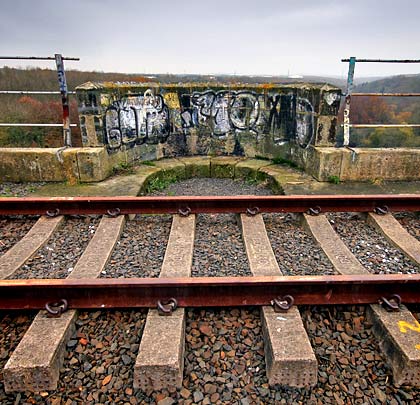Victoria Viaduct
Victoria Viaduct


















Although it was authorised as a through line by an Act of 1834, the Durham Junction Railway opened to mineral traffic in August 1838 as a five-mile branch between the Stanhope & Tyne line at Washington South Junction and Rainton Meadows. Passenger services began in March 1840. Four years later it became part of the Newcastle & Darlington Junction Railway and hence the East Coast Main Line, but this elevated status lasted only until 1868 when the North Eastern opened a shorter link between Newton Hall Junction, north of Durham, and Gateshead. Under the banner of the Leamside line, its remaining life was spent serving local passenger and freight trains, occasionally acting as a useful ECML diversion.
Based on the Roman bridge at Alcántara in Spain, the route’s most significant engineering work was the Victoria bridge, later retitled Victoria Viaduct. Designed by Thomas Elliot Harrison and built from rusticated sandstone by James Walker, it carried its two tracks over the River Wear at a height of 135 feet. Work started in 1836 and the official opening coincided with Queen Victoria’s coronation on 28th June 1838.
The remarkable structure comprises four vast arches – the middle two boasting spans of 160 feet (over the river) and 144 feet, with the others measuring 100 feet. Beyond these were king piers and then three small approach spans of 20 feet each. Of Britain’s remaining masonry railway viaducts, it has a single span surpassed only by Ballochmyle Viaduct on the Glasgow Paisley Kilmarnock & Ayr Railway to the north-west of Cumnock. Designed by John Miller, that one reaches 181 feet in length.
The top of Victoria’s parapet is 156 feet above its foundations. The main arches, with their voussoirs and bands, sit on huge two-stage piers; above them are semi-circular buttresses which extend upwards to form trackworker refuges on both sides of the track.
Regular passenger services on the Leamside line succumbed to the Beeching cuts in May 1964. The viaduct enjoyed a significant refurbishment in 1989/90 but, with Durham coal traffic dwindling, the line was mothballed in 1991 following the demise of Follingsby freight terminal. By then, the structure had received its Grade II* listing.
Tyne & Wear Passenger Transport Authority commissioned a study into the Leamside’s future in 2006, citing the potential for reopening it as part of the local commuter network or the Metro. It continues to appear in regional transport plans but none has resulted in a firm proposal.
(Sunderland Public Library’s photo, taken from Flickr, is used under this Creative Commons licence.)







